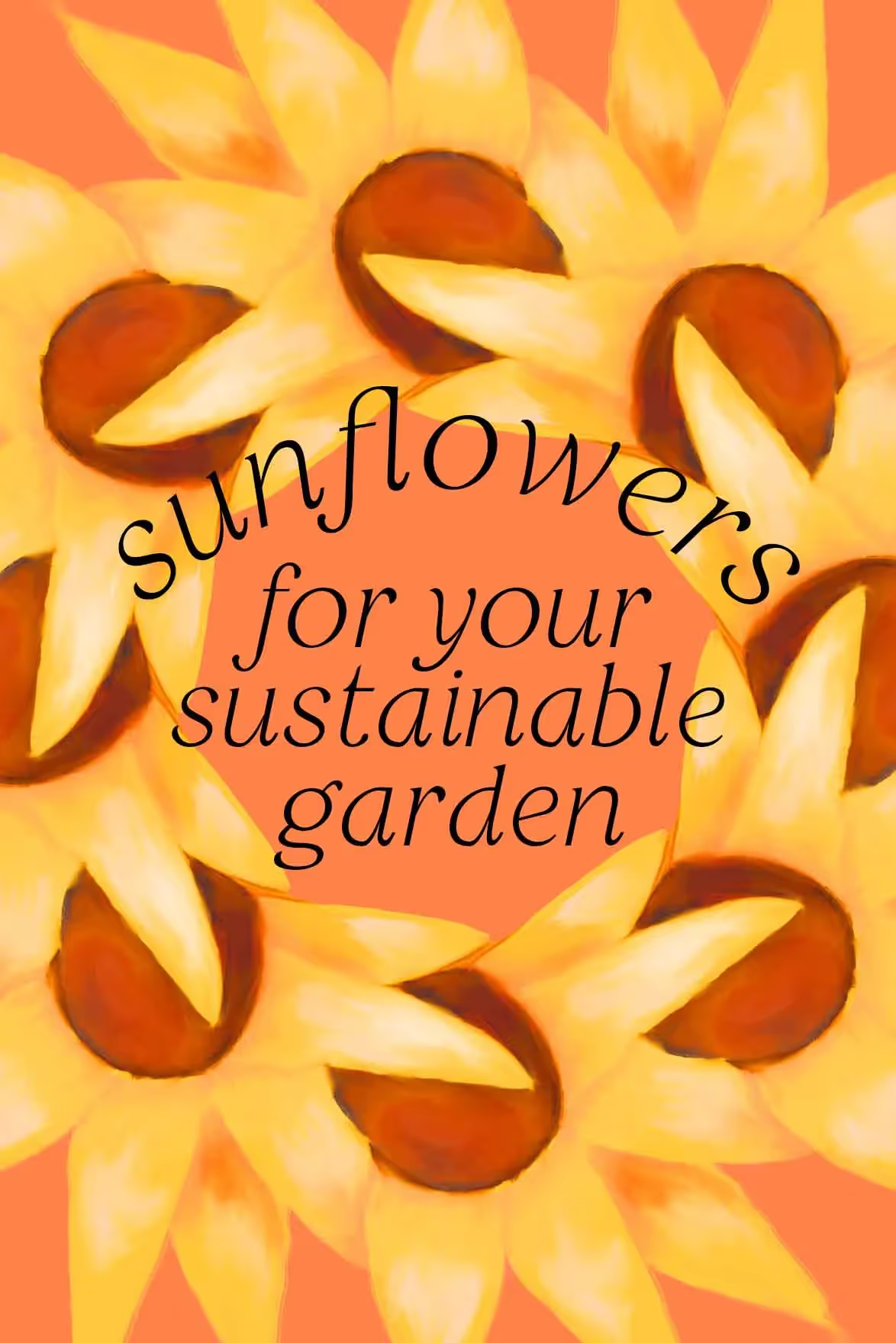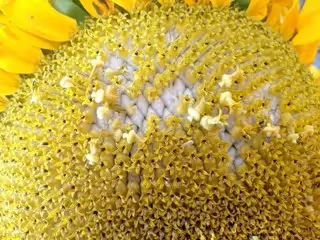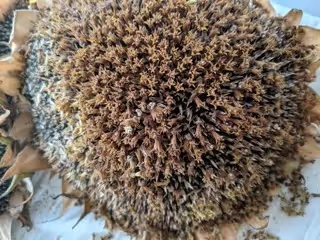
Be a Land Steward.
Sign up for Greenhouse Gases -
a weekly-ish newsletter that will teach you the science behind regenerative gardening, with action steps to help you make a difference in your backyard.

Sign up for Greenhouse Gases -
a weekly-ish newsletter that will teach you the science behind regenerative gardening, with action steps to help you make a difference in your backyard.

The earliest human use of sunflowers is believed to have been four thousand or more years ago (missouri.edu), and in modern times sunflowers are grown not only for their beauty and tasty seeds, but also as a way to support land remediation and climate change adaptation.
Sunflowers are easy to grow, and with their ability to provide a source of fat and protein via their seeds, they are a must-have for anyone looking to build more self-sufficiency into their garden space.
The scientific name for sunflower is Helianthus annus, which comes from the Greek words “helios,” meaning sun, and “anthus” meaning flower. “Annus” means annual (a plant that only grows for one season and then dies back) in Latin.
Helios is also the name of the Greek god of the sun, often depicted as riding a horse-drawn chariot through the sky, personifying the sun itself.
If you want to really nerd out with me, here’s a quote from none other than Socrates talking about the Greek etymology of the word:
Socrates: What, then, do you wish first? Shall we discuss the sun (Ἥλιος), as you mentioned it first?
Hermogenes: By all means.
Socrates: I think it would be clearer if we were to use the Doric form of the name. The Dorians call it Ἅλιος. Now ἅλιος might be derived from collecting (ἁλίζειν) men when he rises, or because he always turns (ἀεὶ εἱλεῖν) about the earth in his course, or because he variegates the products of the earth, for variegate is identical with αἰολλεῖν.
— Plato, Cratylus.
I like thinking of the light of the sun as collecting humans and animals alike to wake up and start their day.
In Spanish and Italian, sunflower is girasol/girasole, where “gira” means to turn and “sol” means sun. This is in reference to the way that sunflowers follow the sun in the sky throughout the day, facing east, then straight upwards, then west as the sun sets - especially when the plants are young (source).
The sunflower is indigenous to the plains and prairies in the western part of the North American continent. While we most often think of a sunflower as having yellow petals, there are lots of different colors that are now available as cultivars (source).
Sunflowers are actually a dye plant! The yellow petals and the seeds can be turned into a dye. One of the most popular sunflowers for dye is the Hopi Black Dye Sunflower.
The tallest sunflower ever recorded by Guinness Records was 30 feet and 1 inch tall!
While the abundance of seeds in most sunflowers supports their population from year to year, there is one endangered sunflower species: the whorled sunflower. This perennial sunflower grows in the southeastern United States, and is endangered due to habitat loss.

Sunflowers are able to grow in just about any kind of climate, soil, and don’t flinch at hot dry weather. This provides a reliable food source for pollinators, birds, animals, and humans alike throughout the sunflower’s native habitat of the Americas.
Because of their resilience and adaptability, sunflowers are a pioneer species (in more than one way!) for environmentalists to understand how plants can thrive in the face of extreme weather conditions, so that we can breed plants to have the same traits as the survivalist sunflowers (learn more about the research being done here).
Sunflowers are a low-maintenance crop, needing little input. They grow well without added fertilizers and pesticides, and do not need irrigation at the same level as other plants. Since synthetic fertilizers and pesticides are made from fossil fuels and are environmentally damaging, sunflowers are a great way for farmers and gardeners alike to add a crop to their land without harming the surrounding ecosystem (source).
What’s great is that growing sunflowers organically can provide 90% of the yield as sunflowers grown with synthetic inputs, which is a great result (Lieven and Wagner, 2012).
Sunflowers are known for providing nectar and pollen to bees.
The sunflower is actually a compound flower, meaning that it’s actually made up of hundreds of small flowers. What we commonly think of as the center of the sunflower, often brown in color, is actually where all of the flowers are located.
Because of this, a single sunflower can hold lots of nectar, as each small flower in its center produces this pollinator food source. The sunflower is also an abundant source of pollen, making it a must-have in your pollinator garden (LBJ Wildflower Center).
Learn more about ecosystem services in our full guide.
According to the University of Arizona Extension, sunflowers are a great way to deter both aphids and stink bugs away from other plants in the garden.
Texas A&M University shares that sunflowers make for a great companion plant for tomatoes that suffer from stink bug damage. They advise to start the sunflower early in the season, as the stink bugs are attracted to the blooms, and starting them early will ensure that the sunflowers are developed at the right time in the growing season.
Sunflowers can be a great option to rotate with Phacelia as a summer-grown cover crop. According to EcoFarming Daily, the large root system of sunflowers can help to build soil health and tilth, alleviating compaction. Sunflowers can help source zinc and magnesium from the depths of the soil, and when cut back, offer those nutrients to the next crop.
Sunflowers are hyper-accumulators, meaning that they are able to draw up minerals from the land and store those minerals in their plant tissue.
This characteristic of sunflowers has been studied as a way to remediate land that has been contaminated with heavy metals, such as lead, copper, and cadmium.
Recently, a study conducted in Turkey affirmed that sunflower is capable of removing zinc, and storing it in the shoots of the plant. They also found Copper and Lead to be removed from soil, and stored in the sunflower’s roots.
The University of Hawaii states that sunflowers also are able to filter heavy metals out of water with their roots. Studies have shown that sunflower can reduce levels of metals such as lead, copper, zinc, nickel, cadmium from water - in as little as 24 hours!
Many people who are on the path to self-sufficiency wonder if sunflowers and sunflower seeds can be eaten by livestock to supplement their diet.
Happily, sunflowers not only can be eaten by livestock, but they also have some great health benefits too.
One thing to keep in mind is that sunflower seeds should be a supplement to a balanced diet, and not a main component.
We personally purchase organic USA grown sunflower seeds for our goats right now, but are working on growing enough sunflowers to at least supplement their sunflower seed intake.
Sunflower seeds have protein and fiber, both of which are necessary for goat health (plant native).
Some say that sunflower seeds are a natural dewormer for goats, but I have not found any scientific studies on this.
Chickens love sunflower seeds! [University of Kentucky](https://afs.ca.uky.edu/poultry/sunflower-seeds#:~:text=Research has shown that whole,rise in yolk cholesterol content.) shares that egg-laying chickens can have up to 30% of their diet be sunflower seeds. However, it may cause the egg yolks to have a pale color. We personally only give sunflower seeds to our chickens as a treat, and it seems to be one of their favorites!
best sunflowers for seed production:
best sunflowers for bouquets and beauty:
best option for your dye garden or for trying something new
best sunflowers for edible roots:
I like to get a head start on growing sunflowers, so I grow them indoors a couple of weeks before my last frost date.
Sow 1 seed per tray cell, and bury the seed as deep as it is long.
Sunflowers really thrive in warm weather, so I like to wait until nighttime low temperatures are in the mid-50’s before I plant these out into the garden.
You can also direct sow them with ease, around 4 inches apart, once you’re well in the clear from your last frost.
Water regularly until seeds sprout, then water as needed. Remember that sunflowers are drought tolerant.
Sunflowers usually mature in around 3 months, you will likely start getting cut flowers in July and into August/September, with seeds being ready for harvest and eating in September and October.
You might need to use a stake to support your sunflower from falling over as it grows tall and heavy.
Most plants like well-drained lush soil with perfect watering and nutrient conditions, and sunflowers are no different.
It should be noted, though, that due to the adaptability of sunflowers, you should try to plant them in your garden regardless of soil quality. Sunflowers have been known to grow in environments from salt marshes to sand dunes, from deserts to rainy zones (qz).
According to the University of Arizona Extension Office, sunflowers and potatoes should not be planted together. This is because sunflowers release a growth inhibiting chemical that potatoes are especially sensitive to.
Washington College shares that sunflowers typically have between 1,000 to 2,000 seeds in each flower. You’ll probably need around 4-6 sunflowers to yield a pound of seeds (True Leaf Market).

Usually sunflower seeds are ready to be harvested in the early autumn.
My indicator for cutting the sunflower head off of the stalk is when the yellow parts in the center easily fall off. From there I let the sunflower heads dry in a cool area of my pantry.
The seeds will easily fall out of the head, and will taste good. You can cure the seeds in a dry place for a few weeks to let things dry up for easier storage.

While you can eat sunflower seeds raw, or preserve them by drying, you can also roast them easily in the oven to enhance the flavor of the seeds (Wash Coll).
The National Sunflower Association recommends soaking your unhulled sunflower seeds in a salt water solution overnight, and then spreading the seeds out on a baking sheet. With the oven set to 300 degrees F, the seeds should roast fully in about 40 minutes. For more even cooking, carefully (using a hand mitt to protect your self!) stir the seeds about half way through cooking time.
When processed like this, the seeds can be stored for later use.
If you add oil or butter to the seeds when roasting, they should be eaten within a few days.
Know that you know how to grow sunflowers from seed, you will have them sprouting up in your garden in no time! Sunflowers are beautiful and offer a range of ecological services to our gardens and environments. As a relatively low-input crop coupled with their ability to provide a source of fat and protein via their seeds, they are a must-have for anyone looking to build more self-sufficiency into their garden space.
Before you go, if you are interested in growing a nutrient-dense garden that will help you to be more self-sufficient, check out my guide on nutrient dense foods that you can plan on growing in your garden this year.
In the same survival-gardening vein, I also have a guide on crops to grow that offer easy long-term storage, so that you can enjoy them throughout the winter months.